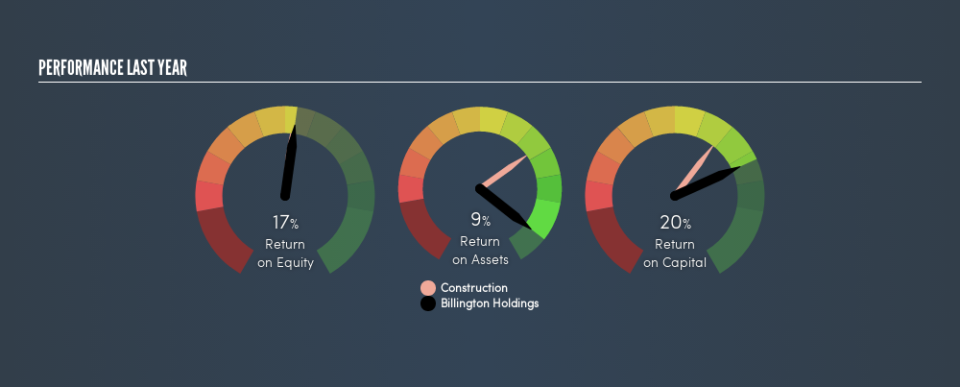Are Billington Holdings Plc’s (LON:BILN) Returns On Investment Worth Your While?

Want to participate in a short research study? Help shape the future of investing tools and you could win a $250 gift card!
Today we'll look at Billington Holdings Plc (LON:BILN) and reflect on its potential as an investment. In particular, we'll consider its Return On Capital Employed (ROCE), as that can give us insight into how profitably the company is able to employ capital in its business.
First, we'll go over how we calculate ROCE. Then we'll compare its ROCE to similar companies. Last but not least, we'll look at what impact its current liabilities have on its ROCE.
What is Return On Capital Employed (ROCE)?
ROCE measures the amount of pre-tax profits a company can generate from the capital employed in its business. In general, businesses with a higher ROCE are usually better quality. Ultimately, it is a useful but imperfect metric. Author Edwin Whiting says to be careful when comparing the ROCE of different businesses, since 'No two businesses are exactly alike.'
How Do You Calculate Return On Capital Employed?
The formula for calculating the return on capital employed is:
Return on Capital Employed = Earnings Before Interest and Tax (EBIT) ÷ (Total Assets - Current Liabilities)
Or for Billington Holdings:
0.20 = UK£5.0m ÷ (UK£45m - UK£20m) (Based on the trailing twelve months to December 2018.)
Therefore, Billington Holdings has an ROCE of 20%.
Check out our latest analysis for Billington Holdings
Does Billington Holdings Have A Good ROCE?
One way to assess ROCE is to compare similar companies. It appears that Billington Holdings's ROCE is fairly close to the Construction industry average of 18%. Setting aside the comparison to its industry for a moment, Billington Holdings's ROCE in absolute terms currently looks quite high.
Remember that this metric is backwards looking - it shows what has happened in the past, and does not accurately predict the future. Companies in cyclical industries can be difficult to understand using ROCE, as returns typically look high during boom times, and low during busts. This is because ROCE only looks at one year, instead of considering returns across a whole cycle. Future performance is what matters, and you can see analyst predictions in our free report on analyst forecasts for the company.
Do Billington Holdings's Current Liabilities Skew Its ROCE?
Current liabilities are short term bills and invoices that need to be paid in 12 months or less. Due to the way the ROCE equation works, having large bills due in the near term can make it look as though a company has less capital employed, and thus a higher ROCE than usual. To counter this, investors can check if a company has high current liabilities relative to total assets.
Billington Holdings has total assets of UK£45m and current liabilities of UK£20m. As a result, its current liabilities are equal to approximately 44% of its total assets. Billington Holdings's ROCE is boosted somewhat by its middling amount of current liabilities.
What We Can Learn From Billington Holdings's ROCE
Even so, it has a great ROCE, and could be an attractive prospect for further research. There might be better investments than Billington Holdings out there, but you will have to work hard to find them . These promising businesses with rapidly growing earnings might be right up your alley.
If you like to buy stocks alongside management, then you might just love this free list of companies. (Hint: insiders have been buying them).
We aim to bring you long-term focused research analysis driven by fundamental data. Note that our analysis may not factor in the latest price-sensitive company announcements or qualitative material.
If you spot an error that warrants correction, please contact the editor at editorial-team@simplywallst.com. This article by Simply Wall St is general in nature. It does not constitute a recommendation to buy or sell any stock, and does not take account of your objectives, or your financial situation. Simply Wall St has no position in the stocks mentioned. Thank you for reading.

